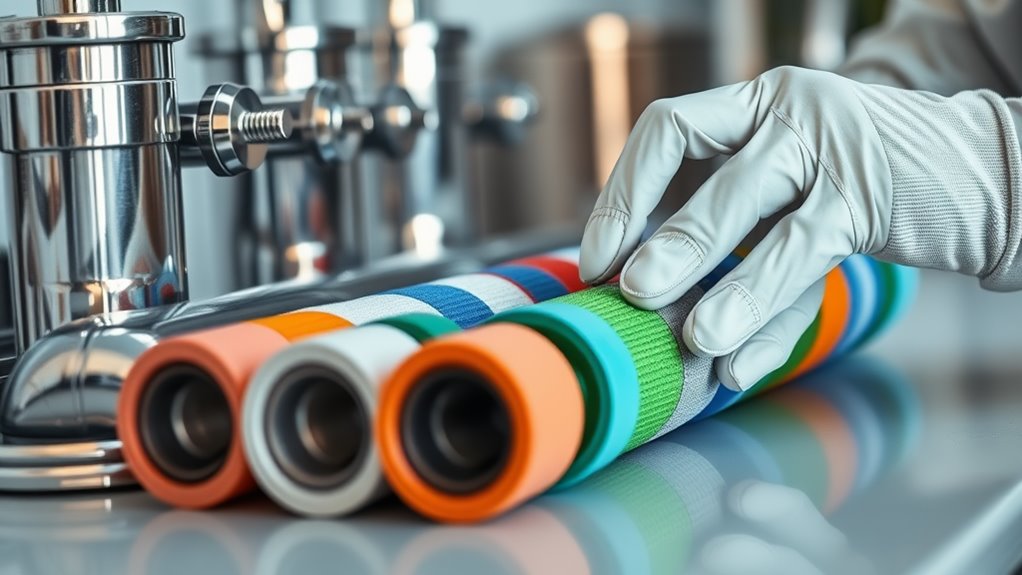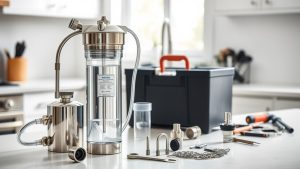
To replace your water filtration system, start by turning off the power and water supply, then locate and access the filter housing. Remove the old filter carefully, catching any residual water. Clean the housing, inspect and lubricate the O-ring, and install the new filter securely. Gradually restore water flow while checking for leaks. Proper preparation and following these critical steps can guarantee a seamless replacement, and you can discover more helpful tips to streamline the process.
Replacing your water filtration system is essential for maintaining clean and safe drinking water. To guarantee a smooth process, preparation and planning are critical. First, select the appropriate filter that matches your system's specifications and is designed to remove the specific contaminants present in your water supply. Gather all necessary tools ahead of time, including a wrench, filter housing tool, bucket, gloves, and O-ring lubricant.
Replacing your water filtration system is crucial for safe drinking water; proper preparation and the right tools ensure a smooth replacement process.
Also, remember to turn off the main power supply to any electrical components connected to your filtration system to avoid any accidents while working. Additionally, it's important to note that customer service hours can be a valuable resource if you encounter any issues during the replacement.
Next, locate your filter housing. Most systems are found under the sink, in a utility closet, or near the main water entry point. Look for a blue or white filter housing, which usually has specific brackets for mounting. Confirm that the area is easily accessible to prevent future maintenance challenges.
Check if you need to access any additional valves or components, and refer to previous maintenance records to track how often you've changed the filter.
Before proceeding with the replacement, locate the shut-off valves near the filter or on the cold water line. Turn these valves clockwise to stop the water flow. If there are multiple valves, confirm they're all shut off.
After closing the valves, check that the water supply has stopped by inspecting a nearby faucet. To further prepare, open a faucet to release any built-up pressure in the system, which helps prevent spills during removal.
Once you've relieved the pressure, you can remove the old filter. Depending on the type of filter, you may need to use eject buttons for push-in filters or twist counterclockwise for twist-in designs. For housing-type filters, a wrench may be necessary to remove the housing.
Place a bucket under the filter housing to catch any residual water and dispose of the old filter responsibly.
After removing the old filter, clean the filter housing with warm soapy water, guaranteeing you remove any debris. Rinse thoroughly to avoid soap residue, and inspect the O-ring for wear.
Replace the O-ring if it's damaged, and apply O-ring lubricant to create a secure seal. Allow the filter housing to dry completely before installing the new filter.
When you're ready to install the new filter, remove any protective caps. For push-in filters, align and push until you hear a click. For twist-in filters, insert and turn clockwise to secure it.
For housing-type filters, place the new cartridge inside and screw the housing back on, tightening it securely but avoiding over-tightening to prevent damage.
Finally, reactivate the system by gradually turning on the water supply. Monitor for any leaks as the system pressurizes. Observing the system for a few minutes will guarantee everything is functioning correctly.
Following these essential steps will help you maintain an effective water filtration system, providing you with clean and safe drinking water.
Conclusion
In summary, replacing your water filtration system is like tuning up a car; regular maintenance keeps it running smoothly. Just as you wouldn't ignore a check engine light, don't overlook the signs of a worn-out filter. By following these essential steps, you guarantee your water remains pure and safe. Remember, clean water is essential for your health—just as a well-maintained vehicle is important for a safe journey. Stay proactive, and your filtration system will serve you well for years.



